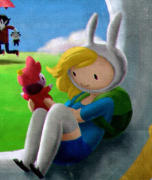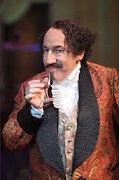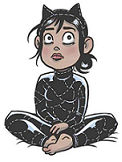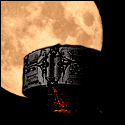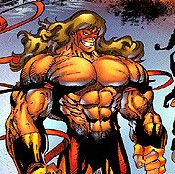|
There’s a fight scene at the end of The Fellowship of the Ring where someone gets impaled. It’s about fifty seconds long and has sixty-six cuts that turn it into a near-incomprehensible mess.  There’s a sequence at the end of John Boorman’s Excalibur where someone gets impaled that’s about as long. It has eight cuts.  This is the thread for discussing fantasy movies, especially ones better than Peter Jackson’s terrible Lord of the Rings trilogy. BravestOfTheLamps fucked around with this message at 10:17 on Feb 5, 2019 |
|
|
|

|
| # ? Apr 25, 2024 02:31 |
|
Fritz Lang’s Die Nibelungen, based on the Medieval German epic poem, is the greatest fantasy movie ever made. The Friedrich Wilhelm Murnau Foundation completed their restoration of the the two-part epic by 2010, and it serves not only as a corrective against Peter Jackson’s overrated movies, but also against non-Zack Snyder comic book adaptations. The first part follows the story of Siegfried, who defeats a dragon, is rendered invincible by bathing in its blood (save where a linden leaf managed to cling), and claims the enchanted treasure of the dwarf Alberich. To gain the hand of the Burgundian princess Kriemhild, Siegfried uses sorcery to help her brother King Gunther to marry and tame the warrior-queen Brunhild. When she discovers this treachery, Gunther conspires with his retainer Hagen Tronje to kill Siegfried in order to preserve his royal dignity. Siegfried is slain by Hagen Tronje, and when Kriemhild demands justice, her brothers are by bound by honour to stand with Hagen.     In the second part there are no more dragons or sorcery, and the enchanted treasure is buried by Hagen Tronje at the bottom of the Rhine, while Kriemhild agrees to marry Attila the Hun to further her vengeance. After a son is born to Kriemhild, her clan is invited to visit the court of Attila. There she instigates a battle between the Nibelungs and the Huns in which her son is killed, and the Nibelungs are besieged in Attila’s great hall. They perish in battle, fire, and execution. Hagen is slain by Kriemhild, who in turn is slain by her outraged retainer. The cycle of tragedy is completed and the myth of the Nibelungs ends.     From Siegfried forging a sword and the first glimpses of Worms, to the burning of Attila’s great hall and Volker playing a mad accompaniment to the doom of the Nibelungs, Lang presents a haunting, mythic vision of glory and collapse. In the first part, we are presented with embodiments of fantasy – Siegfried is that of heroism, Worms is that of civilization, and the Nibelung treasure is enchantment itself. In the second, we are met with their negations – Attila the Hun, the wild men he leads, and the destruction of the Nibelung clan. Lang understands the value of an image and how to linger on one. Anyone who watches Fellowship of the Ring will find themselves unimpressed by the sight of two titanic statues when the camera whizzed past them all too fast, but no one who watches Die Nibelungen will forget the comparatively humble castle of Worms. The Romanesque fortress is lit and shot with all the surreal coldness and stillness of a Giorgio de Chirico painting (bridging history and modernity). And when one is led to the murk and muck of the Hunnic court, one may be startled to realize that they now miss the despotic bareness of Worms.     Some movies are misguidedly praised for looking like comics. The static, geometrical compositions of Die Nibelungen managed to predict and surpass the language of adventure comic books. The movie looks like Prince Valiant in motion. If Lang’s Metropolis is a wellspring of popular culture, Die Nibelungen is a bridge – uniting high and low culture, history and modernity, Medievalism and Expressionism, the intellectual and the popular. Its ponderousness likely limit its audiences today, but no contemporary movie can enchant them the same way. It’s all a lesson in how much popular culture can forget. Die Nibelungen appears strangely progressive for a movie nearing its centennial, especially in its feminist intimations. Hanna Ralph’s Brunhild is a cruel betrayer, but her machinations have a measure of justice and reason in them. Margaret Schön in the role of Kriemhild is one of the most indomitable women in the history of cinema, transforming from a meek maiden into the intractable nemesis of her clan. Today it seems many movies receive a stamp of progressive approval as if passing through a factory line, and one wonder how many viewers wowed by them will go back to appreciate Die Nibelungen. Tolkien’s fans may bemoan the quasi-racist depiction of the Orcs (if they’re not applauding it) – how many will watch a movie where “orcs” are a sympathetic party? And in a time of apocalypse anxiety, the Ragnarok-like conclusion of Part 2 is as powerful as it ever was.     This is not a story of good and evil, but of people and the choices they make, until the bitter end. What makes each hero noble is also what makes them ignoble, and what makes each villain ignoble also makes them noble. Siegfried, that exemplar of Aryan manhood, is a hero – and also a vainglorious brute doomed by his own adventurism. Kriemhild follows a path of merciless, self-destructive vengeance in order to exact justice. King Gunther's weakness of character makes him deeply sympathetic even as he orders the death of his blood-brother. Attila, in his wild crudeness, is the only character who does not deceive. Hagen’s ruthlessness is nothing more than extreme loyalty to the Nibelung clan, while Brunhild’s cruelty stems from her desire for freedom. Even Alberich, the only purely malicious character, appears to transcend notions of good and evil as the inhuman guardian of wonders such as the Nibelung treasure. Above all the heroes' victories are always also their failures, which lead them to their ruin.  The dragon that Siegfried slays appears, in all candour, to be merely an innocent animal, and one that in Lang’s adaptation manages to exact its revenge on Siegfried. The treasure he wins from Alberich, even if not unjustly, was still never his to take. The unwavering loyalty that binds King Gunther and his brothers to Hagen Tronje is also a declaration of the shame and guilt over the fate of Siegfried, which encourages them to try to preserve their honour even when it has been already lost. The dream of aristocratic, feudal heroism proves unsustainable. When the fantasies of the first part are all destroyed and negated, we yearn for them, but must recognize their impossibility. Probably the most valuable thing a work of fantasy can do is to disabuse its audience from itself – to reveal itself as something that we cannot and should not have, and to explain to us why we would desire it. The Nazis could not learn this lesson, for living out the movie was their raison d'etre. Die Nibelungen is perhaps the finest illustration of the nature of myth available to us – not expansive and illimitable, but hermetic and closed. The world of Lang’s Nibelungenlied appears as one of closed horizons, cavernous spaces, inescapable antagonisms, and inward movement (collapse, after all, is nothing but inward movement). A stirring camera sweep, as we might find in Lord of the Rings movies, is in this sense anti-mythic. Die Nibelungen is deliberately anti-naturalistic, its compositions artificial, its sequences chaptered, its characters types, their actions rigid and lurching, and their sentiments overacted. One has the impression of a hard, repellent surface under which unimaginable energies boil.     To overcome the apparent contravention of every “common-sense” storytelling principle we know today, one must be able to grasp these energies, and this task is aided by a soundtrack whose recurring leitmotifs key perfectly into the movie’s emotional, narrative, and philosophical affects (it's not Wagnerian, as one might expect). The viewer is won over at the latest by the rising and falling piano trills that accompany Brunhild, which instil a sense of approaching danger that is never thereafter dispelled. Siegfried’s theme is appropriately banal in its valiant cheer and draws us into his not-so-inspiring heroics. The romantic theme of Siegfried and Kriemhild is made memorable by its mourning, yearning reprises. The Hunnic march with its harsh strings and horns has an alien quality that foreshadows the dance of the Oprichniks in Ivan the Terrible. Everywhere the music infuses the narrative with a sense of historical destiny: the figures of the story appear animated and moved by forces greater than them, all the way into the abyss. BravestOfTheLamps fucked around with this message at 20:58 on Feb 22, 2019 |
|
|
|
That was an interesting analysis. As an uncultured swine I don't think I would enjoy watching this movie (and why is it so yellow? Is that an artistic decision or the effect of aging?) but I did enjoy reading about it. And the shots look nicely composed.
|
|
|
|
Ccs posted:(and why is it so yellow? Is that an artistic decision or the effect of aging?) Before the FWM restoration, the movie was available only in black-and-white versions, but it was originally tinted yellow in reference to the idea of "Rhinegold". The restoration is tinted like the original, through dye.
|
|
|
|
The Lord O' The Rings is pretty good, but this looks rad as hell and I will watch it as soon as I figure out where I can. You skate the borders of the quarantine zone though, stalker
|
|
|
|
BravestOfTheLamps posted:Today it seems many movies receive a stamp of progressive approval as if passing through a factory line, The modern archetype of the hero is, at best, "FBI agent" (and we count ourselves lucky when it isn't "CIA agent"). "An average twenty-eight-year-old man who gains the ability to use the full extent of his brain's capabilities is hired by the F.B.I. as a consultant", somehow, is not a joke Am I wrong, or do I see a strong Romantic influence on the visuals? Especially in the second scene, it reminds me a lot of Gustave Doré's illustrations for the Divine Comedy (was Doré a Romantic? I can't find a straight answer). Speaking of which, have you ever seen L'Inferno? I've never been a fan of the Romantic treatment of fantasy themes, I see Romanticism as patient zero of the naturalistic approach to fantasy/mythology/ancient history, so I'm a little surprised to recognize its influence here. Maybe I'm just seeing things
|
|
|
|
hackbunny posted:Am I wrong, or do I see a strong Romantic influence on the visuals? Especially in the second scene, it reminds me a lot of Gustave Doré's illustrations for the Divine Comedy (was Doré a Romantic? I can't find a straight answer). Speaking of which, have you ever seen L'Inferno? It's extremely Modernist. It's pretty much anti-Romantic. hackbunny posted:Speaking of which, have you ever seen L'Inferno? I already read it
|
|
|
|
BravestOfTheLamps posted:It's extremely Modernist. It's pretty much anti-Romantic. Is Art Nouveau romantic, realist or modernist? none of the three? Maybe I'm just overfitting on a poor sample set BravestOfTheLamps posted:I already read it "The book was better"
|
|
|
|
Btw it's Worms and not Wurms
|
|
|
|
Sorry, it's Wurms now. It's the law.
|
|
|
|
true.spoon posted:Btw it's Worms and not Wurms Worms and wyrms, I can understand the confusion
|
|
|
|
no
Yaws fucked around with this message at 07:14 on Feb 5, 2019 |
|
|
|
no
Yaws fucked around with this message at 07:14 on Feb 5, 2019 |
|
|
|
Yes! Fantasy is rightfully malinged as mostly garbage, but there are a few that are genuinely great, and I look forward to arguing which is which.
|
|
|
|
I loved Brothers Grimm for the deeply flawed movie it was because it actually dealt with Fantasy, what does it mean and the whole point of fairy tales and magical thinking
|
|
|
|
hackbunny posted:Am I wrong, or do I see a strong Romantic influence on the visuals? Especially in the second scene, it reminds me a lot of Gustave Doré's illustrations for the Divine Comedy (was Doré a Romantic? I can't find a straight answer). Speaking of which, have you ever seen L'Inferno? They definitely look like the artworks of Kay Nielsen, Virginia Frances Sterrett or John Bauer, all of whom were pretty rad artists and worth checking out.
|
|
|
|
This is super Romantic at least
|
|
|
|
I'm a big fan of silent era fantasy. The Adventures of Prince Achmed, The Bluebird, and of course the world-renowned classic The Thief of Bagdad.
|
|
|
Blood Boils posted:Yes! Fantasy is rightfully malinged as mostly garbage, but there are a few that are genuinely great, and I look forward to arguing which is which. 
|
|
|
|
Pacho posted:I loved Brothers Grimm for the deeply flawed movie it was because it actually dealt with Fantasy, what does it mean and the whole point of fairy tales and magical thinking You should watch Company of Wolves then, because it does all of that while still being a good movie.
|
|
|
|
|
 Being the story of rise and fall, the height of glory in John Boorman’s Excalibur comes necessarily early. Arthur has drawn the sword from the stone (same as the eponymous blade in this adaptation), but it is not enough to secure his kingship, and he must battle the robber knights led by Uriens. Arthur defeats Uriens and has him at his mercy, but he refuses to swear allegiance to a squire of dubious parentage. With all eyes upon him, Arthur agrees, and gives Excalibur to Uriens so that he may use it to knight him.    Kneeling in the water of the moat, Arthur appears like a man awaiting baptism, but also curiously assumes the role of the Lady of the Lake, the granter of Excalibur and representative of a pagan Otherworld. It is a moment of great ambiguity yet also of deadly certainty: Arthur displays how soldier proves his honour and beliefs in his cause by disregarding his own life, but he also embodies how a Christian must be willing to love his worst enemy. It is the perfect, ultimate act of chivalry. How could Uriens do anything but knight him and swear fealty? How could we in the audience not be enchanted by that transcendent moment, and not regret what will come after? After the peak, the only way is down. If Fritz Lang’s Die Nibelungen is the greatest cinematic work of fantasy, John Boorman’s Excalibur is a runner-up. They share some similarities, as stories of glory and collapse, but the differences are great. Die Nibelungen is an ironic epic, but Excalibur is forthright, more simple, but even more enchanting. The movie has no need for multi-dimensional characters or three-act structures. If nothing else, Excalibur serves to reveal how artificial our conceptions of storytelling can be. Boorman and co-writer Rospo Palleberg ride roughshod over every Screenwriting 101 lesson ever taught. Much of what happens in Excalibur appears inexplicable and demands leaps of intuitive logic from the viewer, such as a fairy-woman gifting swords from beneath water. Sometimes it is clear, such as when Lancelot does battle against his own armour – “I fight against myself”. Sometimes it is less so, as when Arthur striking the earth with Excalibur wounds Merlin. The final battle is fought in a valley, where Percival leaves a wounded Arthur. When he returns, Arthur has crawled to a coast that is revealed to have been right beside the battlefield, as if the world had rearranged itself. Events and patterns recur in different forms, introducing a cyclical sense of destiny and history, two forces which bear heavily upon the characters.     Despite Merlin’s warnings, none can quell the passions – love and hatred – that lead to destruction. The erotic or eroticized nature of their struggles renders each character vulnerable. At times they reveal how painfully they understand their role in the scheme of things. It is perfectly seemly to not buy into the movie’s mystical conservatism: a sense of distance trains the viewer to not be ‘immersed’ in movies, but to consciously reflect on their narrative and philosophy, and learn from them even when we disagree with them. Like Die Nibelungen, Excalibur takes us to the peak of heroic gallantry and then to its antithesis – but only Excalibur rouses us once again with the stunning, unforgettable last ride of Arthur and his knights. The movie’s seeming irrationality drew the ire of critics such as Roger Ebert who preferred the poor, safe escapism of the Star Wars movies. In content the movie is not radical. The plot of Excalibur contains little that cannot be found in Le Morte d’Arthur or any “greatest hits” adaptation of the story: Uther and Igraine, the sword in the stone, the golden days of Camelot, the adultery of Lancelot and Guenevere, the quest for the Grail, Mordred, and so on. But events and characters are combined and transposed with some boldness. Time and space are always amorphous in Excalibur, and in this the movie is both faithful to Arthurian prose romance and radical as cinema. Sometimes the most revolutionary choice is to go back in history. Physical and geographical facts appear mutable and negotiable. Young Arthur follows Merlin into unpopulated wilderness, and following him again finds himself back with his supporters, who are just as surprised to see him. When told that by Lancelot that their destination is a twenty days’ journey away, Percival remarks that the world cannot be so large. Lancelot laughs, but what Percival really means is that time equals space. Days, months, years, a decade meld into each other, allowing the movie to cover the whole breadth of King Arthur’s story. The landscape transforms to reveal new vistas and secrets, especially during the quest for the Grail: untamed forests, burning battlefields, idyllic meadows, forbidding coasts, guarded valleys, empty moors, ancient ruins, wintry mountains, cursed wastes, but also sumptuous or sinister courts.    Camelot (the name is used only twice in order to avoid over-familiarization – England, Britain, and France are never mentioned for the same reason) is glimpsed only partially or at a distance. Social realities are completely ignored: the common people exist only to help illustrate the virtues and failures of the knights. The milieu of Excalibur lopsided, incomplete world where supernatural forces appear to be constantly at work just beyond the corners of our eyes, save for when they reveal themselves in full glory. The camera is usually in soft focus, emphasising the gleam of light on shining plate armour, the verdant green of trees and grass, and the haziness of magical mists. The pacing is alternatively languid and relentless, demanding the viewer adapt to it or else be lost. There are subtleties that belie the movie’s operatic, comic bombast, chiefly the repetition of certain actions and events, which has already been mentioned. Occasionally the movie illustrates the history of Arthuriana. At one point Merlin is seen at work with what appears to be a printing press a thousand years too early. This appears to be an allusion to William Caxton, who is thought to have introduced printing to England and who published Sir Thomas Malory's Le Morte d'Arthur, on which Excalibur is based. The first half of the movie stresses the hard and rough nature of the black-clad British knights. After Arthur is humbled during his battle against the French knight Lancelot, we see that the Knights of the Round Table have all adopted Lancelot’s armour and fine manner, encapsulating the extensive French influence on Britain’s “own” mythology – chivalry after all is a continental invention, as is Arthurian literature.   In its play with time and space, the movie’s identity is so strong that it may be hard to notice how it amalgamates Arthurian interpretations past, present, and even future. Merlin reflects the modern, revivalist interest in the Celtic and pagan residues to be found in Arthuriana. His and Arthur’s philosophizing summarises Medieval and modern debates on ethics, psychology, and religion. Lancelot’s and Guinevere’s adultery is pure Hollywood romance. King Arthur’s court at its zenith recalls the fancies of children’s Arthur stories and of the musical Camelot. Arthur’s submission before Uriens, at the risk of decapitation, distantly resembles the strange contest in Sir Gawain and the Green Knight, one of the most memorable works of Medieval English literature.    The bizarre armours worn by robber knights and Arthur’s foes, along with the less artful sets, evoke cartoon adaptations of the myth. The soundtrack, unlike that of Die Nibelungen, takes directly from Wagner, who also composed Parsifal. The Dragon, the world-spirit which Merlin invokes, recalls The Force wielded by the knights and sorcerers of the contemporaneous Star Wars movies (the quality of the adaptations referenced is largely immaterial). War and battle scenes exemplify historical adventures and action epics. The stories of Uther, Morgan, Mordred introduce grit and horror into the movie. Even Monty Python’s parody is present, as it directly inspired the mud and grime of the kingdom’s darker times – some characters appear as if they were taken straight from Holy Grail, and Niall O’Brien as Sir Kay bears a passing resemblance to Graham Chapman. Zack Snyder’s Batman v Superman: Dawn of Justice is an artful assay in interpreting modern and pop cultural anxieties through the lens of Excalibur.  The one thing Boorman neglects is Christianity, the presence of which tends to be filtered through pagan revivalism. This is a disservice to the Medieval religiosity to which we owe much of King Arthur. An embittered Lancelot’s accusation that the knights set themselves up as gods is too true here. Nevertheless, Boorman treats the archaic, alien values of his interpretation with immense dignity and respect. Despite its occasional New Age trappings, Excalibur appears genuinely pious, something that not many movies can boast of being. No movie will again treat chivalric romance with the same gravitas. The comprehensive, near-encyclopaedic breadth of episodes, influences, and themes makes it the definitive Arthurian movie. The cast’s performances requires some homage. Nicol Williamson as Merlin keeps the ambitious and disparate movie together. He embodies the world of Excalibur without being part of it. The movie’s subtle amalgamate is reflected in Williamson’s ability to assume a multitude of roles – sorcerer, prophet, wanderer, father, advisor, moralist, outsider, clown – all tied together by entertainingly smug theatrical relish. His Merlin is the eternal truth-teller, a philosopher far ahead of Obi-Wan or Gandalf. Nicholas Clay as Lancelot captures infinity in a nutshell by summarising centuries of chivalric literature, for better and for worse: his arrogant, charming confidence is undone by the weakness and shallowness of character that is inevitable to any medieval literary knight. Cherie Lunghi’s Guinevere is adequate as a naïve romantic, although the lack of impression is owed more to a somewhat colourless role than the performance. Helen Mirren makes more of a splash as a Satanist Morgan Le Fay. Paul Geoffrey turns from a Pythonesque peasant into a grizzled, regretful warrior. Liam Neeson and Patrick Stewart are memorable in minor roles, Ciaran Hinds not so much. Hbomberguy has a relatively brief but impressive turn as Mordred. As is always the danger with Arthuriana, it may be easy lose sight of King Arthur himself. Nigel Terry, somewhat astonishingly, manages to portray Arthur’s passage from a teenager to a seasoned leader and into a tired old man without any incongruity (Nicholas Clay’s Lancelot and Paul Geoffrey’s Percival undergo similar transformations, illustrating again the mythic play of time and space). Sometimes bland and sometimes charismatic, Terry reveals that that glory of King Arthur is not in himself, but in always being part of something greater, even if there is no coupling either romantic or Platonic that ends happily in Excalibur.    The sheer ubiquity of Arthur may distract from his importance: the story of King Arthur and his knights has evolved into the ultimate Western myth of leadership, the secular (but still spiritual) equivalent of Jesus Christ. This is why when Percival finally discovers the Grail in Excalibur, what he discovers is Arthur himself. No new adaptation of a story so well-plundered can resist some self-reference, but this reflexivity allows Arthur to explain the nature of myth and legend: he “was not made to live a man’s life, but to be the stuff of future memory”.  And really, who could not love a movie made when it was possible to still use Orff’s Carmina Burana, long before even its ironic usage became trite? BravestOfTheLamps fucked around with this message at 15:59 on Mar 8, 2019 |
|
|
|
BravestOfTheLamps posted:Zack Snyder’s Batman v Superman: Dawn of Justice is an artful assay in interpreting modern and pop cultural anxieties through the lens of Excalibur. The only good thing about Batman v Superman was Supes dissing Batman for being a facist thug that beats minorities and the disfranchised (thus making it a great take on Batman), the rest is a badly written, badly edited mess than can't be saved by its superb photography
|
|
|
|
Great writeup, BotL. I watched Excalibur recently, and besides the excellent Batman v Superman I noticed that Excalibur also had links to Mandy. Specifically, both movies designate weapons and other objects as magical by just blasting them with green light.
|
|
|
|
I'm someone who actually likes Exorcist II, so I'm not sure why I've never tracked down Excalibur, I definitely need to correct that.
|
|
|
|
Excalibur is genuinely excellent and the fact it accurately portrays a pre-Campbell heroic narrative actually makes it revolutionary in its traditionalism
|
|
|
|
I'm the only person who enjoyed King Arthur 2004.
|
|
|
|
BravestOfTheLamps posted:Hbomberguy has a relatively brief but impressive turn as Mordred. hahahahaha gently caress
|
|
|
|
Slutitution posted:I'm the only person who enjoyed King Arthur 2004. I enjoyed it mostly because Clive Owen and Keira Knightley
|
|
|
|
I thought they tried to do that, I thought Arthur was the only actual Roman of the group, Lancelot was from that horse nation, i swear one of the larger guys was a Goth.
|
|
|
|
Slutitution posted:I'm the only person who enjoyed King Arthur 2004. I enjoyed it when I saw it in theater, but the only thing I remember about it is the guy who kept saying his dong looked like a baby arm holding an apple so I dunno.
|
|
|
|
Aces High posted:I thought they tried to do that, I thought Arthur was the only actual Roman of the group, Lancelot was from that horse nation, i swear one of the larger guys was a Goth. Yes but they never do anything interesting with that fact. Even Prince of Thieves and the 13th Warrior played up the contrast between the wordly travellers and the local folk. It's specially sad because Arthur 2004's Vortigern is set up as a genocidal cultural homogenizer but this detail is only to characterize him as a bad guy and miss the opportunity to contrast him with Arthur forming his Knights from all over the roman world. Their foreignness is just dress up for horse-tricks
|
|
|
|
Slutitution posted:I'm the only person who enjoyed King Arthur 2004. You stating this means I need to let it be know that Legend of the Sword is one of my favourite movies. I don't even know why, it just is.
|
|
|
|
JBP posted:You stating this means I need to let it be know that Legend of the Sword is one of my favourite movies. I don't even know why, it just is. It rules
|
|
|
|
Basebf555 posted:I'm someone who actually likes Exorcist II, so I'm not sure why I've never tracked down Excalibur, I definitely need to correct that. Flick is ridiculous in all the best ways and owns. It pops up on Prime now and then. Like it just feels mythical in a ways most movies don't Also I disagree with Bravest of Lamps' posts pretty often but Die Nibelungen is indeed the best fantasy movie ever made for all of the reasons they stated. Holy poo poo that movie rules. Neo Rasa fucked around with this message at 00:42 on Feb 26, 2019 |
|
|
|
From what I remember 2004 Arthur started interestingly but threw the last half of the script into a trash can and went with a giant battle scene. There was so much more they could have done with the story.
|
|
|
|
JBP posted:You stating this means I need to let it be know that Legend of the Sword is one of my favourite movies. I don't even know why, it just is. It's honestly in my top ten most enjoyable movies of all time and I also have absolutely no idea why.
|
|
|
|
For those who find Die Nibelungen too long and ponderous will likely find F.W. Murnau’s Faust, a 1926 adaptation of another classic German myth and Goethe’s closet drama, much more palatable. Murnau – director of Nosferatu, whose posthumous foundation was responsible for the restoration of Die Nibelungen) – draws on the same Expressionist influences as Fritz Lang to illustrate mythic fantasy, but with a running-time reasonable for an evening’s entertainment and a near-riotous pace. The basic premise of the Faust myth is no doubt familiar. Goethe’s Faust introduces, among other things, a wager between Heaven and Hell for the soul of Faust and the tragedy of Gretchen, Faust’s young love. Where Faust is generally driven to sell his soul either out of greed or of dissatisfaction with the limits of learning, Murnau’s Faust is driven by desperation to cure a plague in his city – spread by Mephisto for that very purpose. After being rejected by the people when his abhorrence of the cross ruins his good intentions, Faust succumbs to all the temptations offered by Mephisto, including regaining his youth (old Faust looks like King Lear, young Faust resembles the delicate hero of Fritz Lang’s Metropolis that came out the following year).  Much of the film’s power is owed to the ingenuity of its structure. The first part, roughly half of the movie, is set in a shadowy world of demoniac passions. This is a place of excesses – excess of despair, excess of pleasure, excess of zeal, excess of pleasure, excess of hatred. Everything is in constant flux, characters change shape and mobs change between extremes of emotion. Mephisto changes from colossal archdemon to menacing churl and finally into a stage devil as required. This exhaustion cunningly places the audience in Faust’s position, for no-one is more exhausted by the movie’s wonders than he is. After sampling all that Mephisto can provide, a melancholy Faust reveals a new desire: to return home. This superficially banal wish turns profound when it is fulfilled. When he returns to his home town, the world of shadows and demons is replaced by a world of light and people. The violent mobs and courtly decadence give way to a peaceful, joyous Easter procession.  The movie could have done well by maintaining that tone of dark mania, but this pivoting is what makes the movie an exemplary study of fantasy. A desire for a simpler, sweeter life is universal in humans. Murnau portrays this fantasy in all of its naïve purity: the satisfaction of communal religion, the innocence of children at play, the merriness of happy families, and the ardour of young love. In this world, even Mephisto becomes for a while a harmless clown content to aid and parody the courtship of Faust and Gretchen, who makes faces at a Mass and at Madonna like a petulant child. Faust’s lover embodies this sweet life, and in pursuing Gretchen, Faust ruins her.  Before Gretchen is told to pray before Madonna and the Child, but instead becomes a spat-upon Madonna of the gutters desperately cradling her and Faust’s unfortunate child, Such reversal, parody, or perversion of different images is common throughout the movie. Sometimes this is allusive, more often self-referential, and sometimes even ahead of its time. A colossal Mephisto covering a city in darkness predicts the Night on Bald Mountain sequence in Disney’s Fantasia. While flying to Italy, Faust and Mephisto look like a mockery of Dante and Virgil. Communal devotion is turned to the hateful jeering of the mob. The pageantry at the wedding of the Duchess of Parma appears to have come straight out from D.W. Griffith’s Intolerance.  In the first part, evil and suffering appeared largely impersonal and philosophical. The ruin of Gretchen brings back the darkness and mania, now tempered by her personal suffering so that each step of her tragedy is acutely felt. At the end Faust chooses to return to her and die with her, redeeming both, suffusing everything in light. This leads into the most important of reversal of all. When Faust is seduced by the burning words “Glory” and “Power” on the infernal contract. At the end the Archangel rejects Mephisto’s demands with a single word: a bright, shining LIEBE that trounces the power of Hell and closes the movie. Murnau manages to seize on the score of the Faust myth: the joy and terror of change and metamorphosis. Every scene is a new vision, whether celestial war or the misery of social ostracism and poverty. The power of early special effects are bent fully to this purpose to depict sorcery, illusions, and magical flight. Many movies depict the act of flying, but few attempt to truly capture the experience of flying, which is why Faust’s airborne journey from Germany to Italy remains stunning to this day. Shots of Faust and Mephisto among clouds alternate with a veering shot of miniature landscapes. The first shot begins above rooftops and climbs sideways up a cathedral’s steeple. The distorted view of the town and of the church serves as a visual metaphor for Faust’s alienation from society and religion. The in-studio landscapes serves as counterpoint to the cavernous universe of Die Nibelungen. The grainy picture quality and manipulation of perspective obscure the flaws of the miniature set and accentuates its physicality, which is why this first-person perspective of flight is still unmatched by modern special effects. After this a rural landscape with mountains, an Alpine river-valley, and a passage by the portico of an Italian palace, executed as to flaunt the spectacular artifice. Murnau was a pilot, which explains the sequence’s strange authenticity. CGI technology has made the depiction of flight trivial, but this is limited to portraying objects in flight. The perspective of flight, however, is much harder to capture because it changes and distorts all things.  The superimposed footage used, for example, to create ghostly riders and to capture Faust’s old age in a mirror are less convincing, but not less engaging for it. Gretchen’s scream for her Faust, travelling across the mountains with her transposed crying face, only works in a silent medium where it appears poetic rather than ridiculous. The movie triumphs when itgives greater significance to the individual struggles of Faust and Gretchen. The battle between Heaven and Hell that bookends their tragedy makes their suffering into a cosmic struggle, as the best tragedies do. Also, I watched Zack Snyder’s owl movie and it was good. BravestOfTheLamps fucked around with this message at 16:01 on Mar 8, 2019 |
|
|
|
DeimosRising posted:hahahahaha gently caress 
|
|
|
|
Fault is a good-rear end movie and the shot of the devil overlooking and casting a shadow on the town is incredibly good.
|
|
|
|

|
| # ? Apr 25, 2024 02:31 |
|
the beginning and end of Faust are great but i always have trouble paying attention to anything after the amazing flying scene and before Gretchen's child dies. the opening is as exhausting as it is wonderful.
|
|
|








